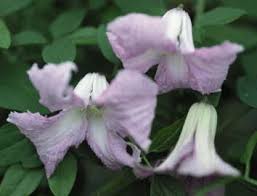
Dharaseeds
Clematis Betty Corning Seeds
Estimated delivery between April 15 and April 18.
Clematis Betty Corning is a charming and beloved clematis variety, known for its unique, soft lavender-blue flowers and graceful, trailing habit. This early-blooming variety is perfect for gardeners looking to add a touch of delicate beauty to their garden. Whether cascading over fences, arbors, or trellises, Betty Corning offers a stunning, long-lasting floral display that attracts bees, butterflies, and other pollinators.
Key Benefits
- Unique Lavender-Blue Flowers: This clematis produces abundant, nodding flowers with a soft lavender-blue hue, making it a standout in the garden.
- Early Bloomer: Betty Corning blooms in early summer, providing a lovely display of flowers when many other plants are just beginning to flower.
- Vigorous and Hardy: This variety is a hardy and vigorous climber, capable of growing up to 8–10 feet tall, and is well-suited for a variety of climates.
- Pollinator-Friendly: The fragrant flowers attract bees and butterflies, making it an excellent choice for pollinator gardens.
- Compact and Versatile: Betty Corning's trailing habit makes it ideal for smaller spaces like patios or for adding cascading beauty to containers and hanging baskets.
Variety Features
- Plant Characteristics: Clematis Betty Corning is a deciduous, twining vine that can reach up to 8–10 feet in height. It produces a profusion of delicate flowers from early summer.
- Flower Size: Each flower is about 3–4 inches in diameter, with a soft lavender-blue color and slightly twisted petals that give it an elegant appearance.
- Growth Habit: The plant has a compact, graceful growth habit, making it suitable for vertical gardens or hanging baskets. It can also be trained to grow along fences and trellises.
- Flowering Period: This clematis variety blooms from late spring to early summer, typically from May to June.
Planting Instructions
Planting Season
- Start Clematis Betty Corning Seeds indoors 6–8 weeks before the last expected frost for a head start, as this variety benefits from an early start.
- Alternatively, sow seeds outdoors in late spring after all danger of frost has passed.
Planting Details
- Seed Depth: Plant seeds about 1/8 inch deep in a well-draining seed-starting mix.
- Spacing: Space plants 12–18 inches apart to allow for proper growth and airflow.
- Soil Requirements: Prefers fertile, well-draining soil with a slightly acidic to neutral pH (6.0–7.0).
- Sunlight: Full sun to partial shade is ideal. In hotter climates, some afternoon shade helps protect the plant from excessive heat.
Care Instructions
Watering
- Keep the soil evenly moist but not soggy. Water deeply once a week during dry periods, ensuring the soil around the plant’s base stays consistently moist.
- Avoid watering overhead to reduce the risk of fungal diseases.
Fertilization
- Apply a balanced fertilizer (e.g., 10-10-10) in early spring as new growth begins to encourage healthy blooming.
- Consider a second application in early summer to promote continued flowering.
Weeding and Mulching
- Regularly weed around the base to prevent competition for nutrients.
- Apply a 2-inch layer of mulch around the roots to retain moisture, keep the soil cool, and suppress weeds. Keep mulch away from the crown to prevent rot.
Pruning
- Clematis Betty Corning blooms on old wood, so it requires minimal pruning. Trim back dead or damaged stems in early spring, before new growth emerges.
- If the plant has grown too large, you can lightly prune it after flowering to control size, but avoid cutting back too much to preserve blooms.
Pest and Disease Control
Pests
- Look out for common pests like aphids, slugs, and snails. These can be managed with organic pest control methods such as neem oil or insecticidal soap.
- Clematis can also be prone to clematis weevil, which damages roots. To prevent this, keep the soil around the plant clean and practice crop rotation in the garden.
Diseases
- To prevent fungal diseases like clematis wilt, ensure good air circulation around the plant and avoid overhead watering.
- Regularly inspect leaves for signs of wilting, browning, or blackening, and remove affected areas promptly.
Harvesting
Maturity
- Clematis Betty Corning typically reaches maturity after 2–3 years from planting, but it can begin blooming within the first year if started from established seedlings.
Harvesting Blooms
- Flowers can be cut for use in arrangements. To extend their vase life, place them in water immediately after cutting, and change the water every few days.
Storage
Short-Term
- Fresh flowers should be stored in water for up to a week. For best results, place the flowers in a cool, dark place away from direct sunlight.
Long-Term
- The flowers of Clematis Betty Corning are not typically preserved for long-term use, but the plant’s attractive seed heads can be collected and dried for ornamental use.
Culinary Uses
- Non-Edible: While Clematis Betty Corning is visually striking, it is not used for culinary purposes. Its value lies in its ornamental beauty.
Conclusion
Clematis Betty Corning Seeds are an excellent choice for gardeners who want to grow a beautiful, early-blooming clematis with soft lavender-blue flowers. With its graceful trailing habit and pollinator-friendly blooms, this variety is perfect for vertical gardens, hanging baskets, or adding color to fences and trellises. Hardy and adaptable, Betty Corning is sure to bring elegance and charm to any garden, while its fragrant flowers attract bees and butterflies. Whether you're a beginner or a seasoned gardener, this clematis variety is a wonderful addition to your garden.











